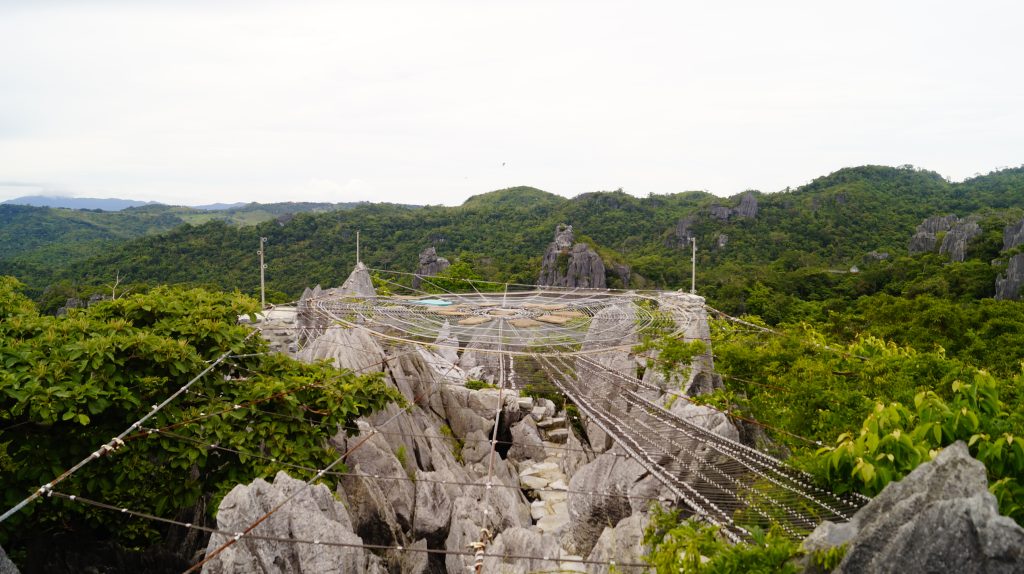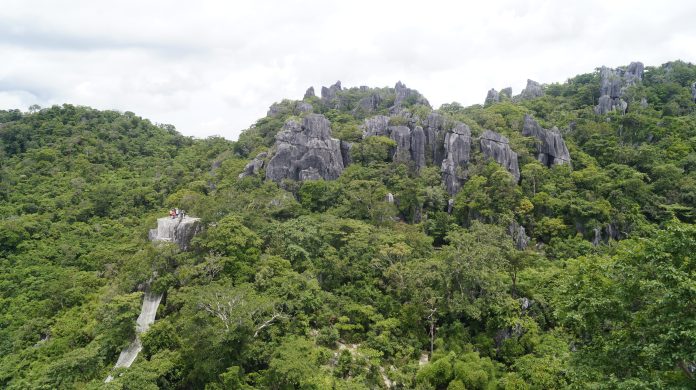Ongoing reforestation of Masungi in Marikina watershed has lessened floods in half of Metro Manila and Rizal. To use it for prison officials’ offices and manors will set off deadly deluges below.
The Department of Environment and Natural Resources should be first to oppose the Bureau of Corrections’ headquartering there. Its silence means consent to the ruinous consequences.
DENR is instead defaming Masungi Georeserve Foundation (MGF) that’s rewilding hillsides by itself. What’s with DENR, which was also mum on the Mindoro oil spill, Romblon illegal mining, and Zambales nickel ore smuggling?
Twenty armed BuCor officers in five vehicles swooped down on Masungi recently. Waving a newly-minted title, they scanned 270 hectares for National Bilibid Prisons and office relocation.
Basic science shows unsuitability. Construction will necessitate levelling of slopes. Uprooting trees will erode soil that shield millions of lowland homes and shops from floods. It will disintegrate the spine of the 65 million-year-old limestone formation that earned Masungi Geopark worldwide renown.
Masungi Foundation protested. Justice Secretary Jesus Remulla, under whom BuCor is, blustered: “Relax lang kayo… Masungi will be preserved but government will use idle portions… You’re not the only ones who can protect nature.” Another science flunker?
BuCor’s “Lot 10” title stemmed from President Gloria Arroyo’s 2006 allocating 270 hectares for 29,200 convicts, plus 30 hectares for DENR regional office. Nearby communities howled. In 2009 then-Secretary Lito Atienza instructed DENR-Southern Luzon to look for other prison and office sites. That year, superstorm Ondoy devastated Metro Manila and Rizal. Floods killed 464.
Two earlier proclamations by President Ferdinand E. Marcos preserved the mountains of Nueva Ecija, Bulacan, Rizal, and Quezon. Focal was Marikina watershed in Montalban, San Mateo, Antipolo, Tanay and Baras of Rizal. In 1993 DENR head Angel Alcala, a national scientist, named Masungi a Strict Nature Reserve and Wildlife Sanctuary, banning quarries and other ecologically harmful activities.
Still, DENR crooks in 1999 granted three 25-year quarry permits on Masungi’s hilltop. In the Baras quarry area rose a dozen picnic resorts sans business permits. Culverts diverted rivers onto swimming pools. Protectors are a retired and an active duty general.
Three years prior, 1996, DENR contracted Blue Star Construction Development Corp. to build environmentally sustainable staff housing on 130 lower hectares. Reforestation began the following year. DENR in 2002 expanded the housing-cum-reforestation into Lot 10’s 300 hectares. There, Blue Star’s Ben Dumaliang saw the degraded limestone ecosystem and restored it to its present state.
With daughters Ann and Billie and ecologists, Ben formed MGF. Wildlife returned within two decades of regreening the first 130 hectares. In 2017, Secretary Gina Lopez tasked MGF to rewild the upper 300 hectares, Lot 10. The illegal resort owners resisted with goons shooting and mauling MGF park rangers.

Present DENR Secretary Antonia Yulo-Loyzaga cancelled the three quarries a year before 2024 expiration. Yet she has not talked to MGF nor appointed a DENR manager for the oversight committee. Then came the BuCor title, which Remulla said he has discussed with her. The Land Registration Authority is also under him.
Yulo twitted the late Lopez’s memo for Masungi to be “a perpetual land trust for conservation … so long as there is no neglect or violation [by MGF].” Supposedly this negates the Constitution’s Article XII, National Economy and Patrimony, Section 2, which limits natural resource concessions to 25 years.
But natural resource preservation is not commercial use. A watershed is for perpetuity. So states the National Integrated Protected Areas System Law.
The National Museum defended MGF, awarded by United Nations and European conservationists. Karst (limestone ridges) need careful management, it said. Masungi’s limestone forest is habitat for unique species of plants, mollusk, crab, other crustacean, insects, fish, reptiles, amphibians, birds, mammals.
Like flora and fauna, limestone formations can degenerate if unprotected. Woodcutting, agriculture, land clearance, quarrying, waste dumping, or landfilling in the vicinity of Masungi geo-tourism park can ruin the karst. Water level and quality can drop.
Wanting quarries back, certain congressmen deride MGF in House hearings. DENR bureaucrats coach them to babble that natural resources must be given away to businessmen for infrastructures. Supposedly floods are inevitable in Marikina, Cainta, Taytay and other cities below. That’s why the valley never was inhabited in olden days.
Wrong! Up to the 1500s Cainta was in fact a kingdom beside Pasig River. It was surrounded by bamboo thicket and fortified with logs and lantaka (Malay bronze cannons). Just that, when Gat Maitan refused to pay tribute to Spain, Juan de Salcedo pillaged it in August 1571 on orders of uncle Miguel Lopez de Legazpi.
Today’s leaders petition to protect Masungi and Upper Marikina Watershed. Signatories are Quezon City Mayor Joy Belmonte, Marikina Mayor Marcelino Teodoro, Pasig City Mayor Vico Sotto, Muntinlupa Mayor Jaime Fresnedi, Angono Vice Mayor Gerardo Calderon, Pasig City Administrator Jeronimo Manzanero and Malabon City Administrator Voltaire dela Cruz.
As well, Marikina barangay chairmen Bernard Bernardo of Sta. Elena, Segundo Cruz of Calumpang, Randy Leal of Nangka, Miguel Punzalan Jr. of Marikina Heights, Rizalina Teope of Fortune, Ronnie Tiburcio of Barangka and Mary Jane Zubiri-dela Rosa of Concepcion.
Jarius Bondoc is an award-winning Filipino journalist and author based in Manila. He writes opinion pieces for The Philippine Star and Pilipino Star Ngayon and hosts a radio program on DWIZ 882 every Saturday. Catch Sapol radio show, Saturdays, 8 to 10 a.m., DWIZ (882-AM).
The views expressed in this article are the opinions of the author and do not necessarily reflect the editorial stance of LiCAS.news.









